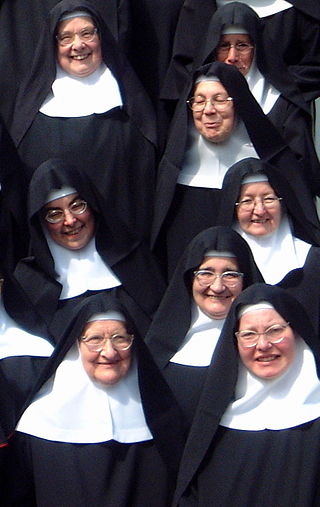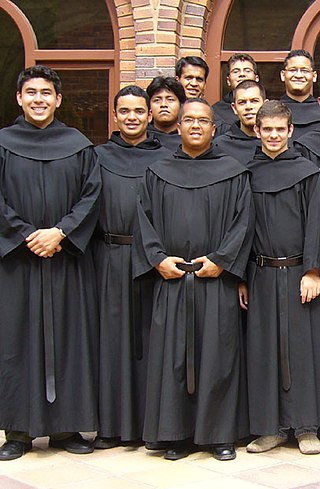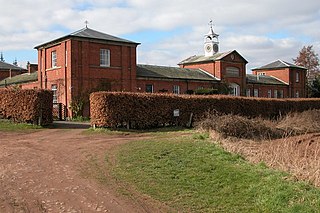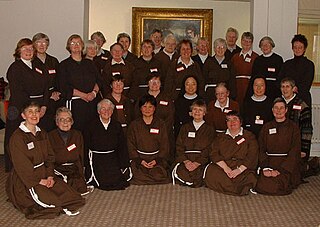
Giovanni di Pietro di Bernardone, known as Francis of Assisi, was an Italian mystic, poet, and Catholic friar who founded the religious order of the Franciscans. Inspired to lead a Christian life of poverty, he became a beggar and itinerant preacher.

A nun is a woman who vows to dedicate her life to religious service and contemplation, typically living under vows of poverty, chastity, and obedience in the enclosure of a monastery or convent. The term is often used interchangeably with religious sisters who do take simple vows but live an active vocation of prayer and charitable work.

The Franciscans are a group of related mendicant religious orders of the Catholic Church. Founded in 1209 by the Italian saint Francis of Assisi, these orders include three independent orders for men, orders for nuns such as the Order of Saint Clare, and the Third Order of Saint Francis open to male and female members. They adhere to the teachings and spiritual disciplines of the founder and of his main associates and followers, such as Clare of Assisi, Anthony of Padua, and Elizabeth of Hungary. Several smaller Protestant Franciscan orders or other groups have been established since late 1800's as well, particularly in the Anglican and Lutheran traditions.

A friar is a member of one of the mendicant orders in the Roman Catholic Church. There are also friars outside of the Roman Catholic Church, such as within the Anglican Communion. The term, first used in the 12th or 13th century, distinguishes the mendicants' itinerant apostolic character, exercised broadly under the jurisdiction of a superior general, from the older monastic orders' allegiance to a single monastery formalized by their vow of stability. A friar may be in holy orders or be a non-ordained brother. The most significant orders of friars are the Dominicans, Franciscans, Augustinians, and Carmelites.

Christian monasticism is a religious way of life of Christians who live ascetic and typically cloistered lives that are dedicated to Christian worship. It began to develop early in the history of the Christian Church, modeled upon scriptural examples and ideals, including those in the Old Testament. It has come to be regulated by religious rules and, in modern times, the Canon law of the respective Christian denominations that have forms of monastic living. Those living the monastic life are known by the generic terms monks (men) and nuns (women). The word monk originated from the Greek μοναχός, itself from μόνος meaning 'alone'.
The Society of the Atonement, also known as the Friars and Sisters of the Atonement or Graymoor Friars and Sisters, is a Franciscan religious congregation in the Catholic Church. The friars and sisters were founded in 1898 by Paul Wattson and Lurana White as a religious community in the Episcopal Church. The religious order is dedicated to the Blessed Virgin Mary under the Marian title of Our Lady of Atonement.

The term third order signifies, in general, lay members of Christian religious orders, who do not necessarily live in a religious community such as a monastery or a nunnery, and yet can claim to wear the religious habit and participate in the good works of a great order. Roman Catholicism, Lutheranism and Anglicanism all recognize third orders.
A religious is, in the terminology of many Western Christian denominations, such as the Catholic Church, Lutheran Churches, and Anglican Communion, what in common language one would call a "monk" or "nun".
The Order of Ecumenical Franciscans (OEF) is a group of men and women devoted to following the examples of Saint Francis of Assisi and Saint Clare of Assisi in their life and understanding of the Christian gospel: sharing a love for creation and for those who have been marginalized. Leadership is shared by a five member council.

The Society of Saint Francis (SSF) is an international Franciscan religious order within the Anglican Communion. It is the main recognised Anglican Franciscan order, but there are also other Franciscan orders in the Anglican Communion.

Anglican religious orders are communities of men or women in the Anglican Communion who live under a common rule of life. The members of religious orders take vows which often include the traditional monastic vows of poverty, chastity and obedience, or the ancient vow of stability, or sometimes a modern interpretation of some or all of these vows. Members may be laity or clergy, but most commonly include a mixture of both. They lead a common life of work and prayer, sometimes on a single site, sometimes spread over multiple locations. Though many Anglicans are members of religious orders recognized by the Anglican Communion, others may be members of ecumenical Protestant or Old Catholic religious orders while maintaining their Anglican identity and parochial membership in Anglican churches.
The Third Order of Saint Francis is a third order in the Franciscan tradition of Christianity, founded by the medieval Italian Catholic friar Francis of Assisi.

The Community of St. Francis (CSF) is a Franciscan Anglican religious order of sisters founded in 1905, and is the oldest surviving Anglican Franciscan religious community. As First Order sisters, the CSF is an autonomous part of the Society of St. Francis, which also includes the Order of St. Clare, and a Third Order of secular members living as a dispersed community. Living under a Franciscan Rule, the sisters' primary vocation is prayer, study, and work in the context of community life. Some sisters serve as priests, and others live a solitary life.

The Secular Franciscan Order is the third branch of the Franciscan Family formed by Catholic men and women who seek to observe the Gospel of Jesus by following the example of Francis of Assisi. Secular Franciscans are not like the other third orders, since they are not under the higher direction of the same institute. Brothers and sisters of the Secular Franciscan Order make a spiritual commitment (promises) to their own Rule, and Secular Franciscan fraternities can not exist without the assistance of the first or second Franciscan Orders. The Secular Franciscan Order was the third of the three families founded by Francis of Assisi 800 years ago.
The Little Brothers of Francis are one of the family of Franciscan orders in the Anglican Communion. They are based in New South Wales, Australia.

Chiara Offreduccio, known as Clare of Assisi, was an Italian saint who was one of the first followers of Francis of Assisi.
A religious brother is a member of a religious institute or religious order who commits himself to following Christ in consecrated life of the Church, usually by the vows of poverty, chastity and obedience. He is usually a layman and usually lives in a religious community and works in a ministry appropriate to his capabilities.
Former religious orders in the churches of the Anglican Communion are those communities of monks, nuns, friars, or sisters, having a common life and rule under vows, whose work has ended and whose community has been disbanded. In a very few cases this is due to the termination of the work for which the community was established, but in most cases it is due to amalgamation or the death of the final remaining member of the community.

The Order of Friars Minor is a mendicant Catholic religious order, founded in 1209 by Francis of Assisi. The order adheres to the teachings and spiritual disciplines of the founder and of his main associates and followers, such as Clare of Assisi, Anthony of Padua, and Elizabeth of Hungary, among many others. The Order of Friars Minor is the largest of the contemporary First Orders within the Franciscan movement.
Franciscans are members of the Order of Friars Minor, a Catholic religious order founded in 1209 by Francis of Assisi.













